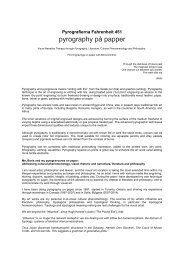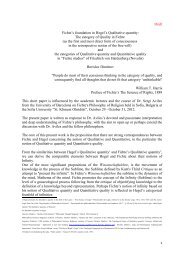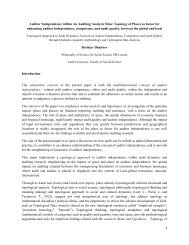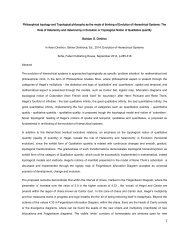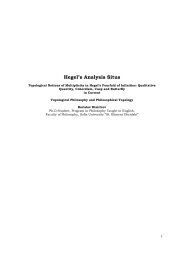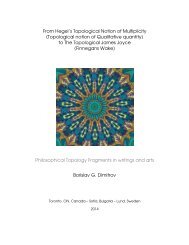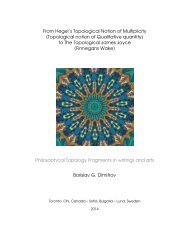Topological Ontology and Logic of Qualitative quantity
Qualitative quantity and BFO (Basic Formal Ontology) of /Barry Smith/ and YAMATO (Yet Another More Advanced Top-level Ontology) of /Riichiro Mizoguchi/
Qualitative quantity and BFO (Basic Formal Ontology) of /Barry Smith/ and YAMATO (Yet Another More Advanced Top-level Ontology) of /Riichiro Mizoguchi/
- No tags were found...
You also want an ePaper? Increase the reach of your titles
YUMPU automatically turns print PDFs into web optimized ePapers that Google loves.
Mereotopology is a first-order theory, embodying mereological <strong>and</strong> topological concepts, <strong>of</strong><br />
the relations among wholes, parts, parts <strong>of</strong> parts, <strong>and</strong> the boundaries between parts.<br />
Mereotopology begins with theories A.N. Whitehead articulated in several books <strong>and</strong><br />
articles he published between 1916 <strong>and</strong> 1929.<br />
The <strong>Qualitative</strong> <strong>quantity</strong> is the base cathegory <strong>and</strong> phenomenom <strong>of</strong> <strong>Qualitative</strong> research<br />
/QR/. <strong>Qualitative</strong> Research utilizes methods that seek to discern the quality — as opposed<br />
to the <strong>quantity</strong> — <strong>of</strong> its subject. QR is more <strong>of</strong>ten concerned with explaining the why <strong>and</strong><br />
how <strong>of</strong> a phenomenon rather than the what, when <strong>and</strong> where. <strong>Qualitative</strong> research<br />
methods are most <strong>of</strong>ten utilized in fields such as anthropology, the humanities <strong>and</strong><br />
sociology, although each <strong>of</strong> these fields can be studied through quantitative methods as well.<br />
Since qualitative research is exploratory <strong>and</strong> focuses on discerning the why <strong>of</strong> things, such<br />
as human behavior, rather than the what <strong>of</strong> the natural world, it is <strong>of</strong>ten criticized for<br />
being too subjective. Many make the counter-argument, however, that since qualitative<br />
methods are hypothesis generating, they are not only just as valuable as quantitative<br />
methods but necessary for the production <strong>of</strong> theoretical models which come to inform the<br />
direction <strong>of</strong> quantitative research methods. Data collection <strong>and</strong> analysis is another way that<br />
quantitative <strong>and</strong> qualitative research differ. In qualitative research, data samples are usually<br />
not collected through r<strong>and</strong>om selection but rather purposive reasoning, which is to say<br />
they are chosen for how well they typify the characteristics <strong>of</strong> a certain class. For example, a<br />
qualitative research study on racial inequality will not likely concern itself with affluent<br />
minorities or the entire population <strong>of</strong> a minority, but rather, it might focus on depressed<br />
areas where minorities are most prevalent. This approach is chosen because qualitative<br />
researchers are not concerned with discerning the <strong>quantity</strong> <strong>of</strong> people in a minority class,<br />
but rather the quality <strong>of</strong> life for minorities who are affected by inequality. <strong>Qualitative</strong><br />
research is thought especially valuable in circumstances where quantitative data does not<br />
account for a particular phenomenon. For example, while economics frequently concerns<br />
itself with collecting concrete information, like statistics <strong>and</strong> financial data, it can be said to<br />
be flawed because it ignores the humanistic <strong>and</strong> psychological aspects <strong>of</strong> the people that are<br />
a key component. This human component requires a qualitative underst<strong>and</strong>ing. An<br />
important variable to consider when analyzing the dependability <strong>of</strong> qualitative research is<br />
validity. It is important to consider how a conclusion was reached, <strong>and</strong> whether it really<br />
represents a dependable <strong>and</strong> realistic interpretation <strong>of</strong> its subject. It may or may not be<br />
pertinent to ask whether or not a conclusion is reproducible, or whether it was affected by<br />
bias. One should also consider whether data from qualitative research is well reasoned <strong>and</strong><br />
the extent to which it accounts for a substantial majority <strong>of</strong> the available data.<br />
Spatial-temporal reasoning is applicable in ontology. The implication <strong>of</strong> the<br />
concept <strong>of</strong> qualitative <strong>quantity</strong> could be found in the work “Spatial Reasoning <strong>and</strong><br />
<strong>Ontology</strong>: Parts, Wholes, <strong>and</strong> Locations”, authored by Achille C. Varzi, Columbia<br />
University /Published in M. Aiello, I. Pratt-Hartmann, <strong>and</strong> J. van Benthem (eds.), H<strong>and</strong>book<br />
<strong>of</strong> Spatial, <strong>Logic</strong>s, Berlin: Springer-Verlag, 2007, pp. 945-1038/.<br />
The notion <strong>of</strong> the Quality <strong>of</strong> the <strong>quantity</strong> is related with <strong>Qualitative</strong> Spatial Change. In<br />
his study “<strong>Qualitative</strong> Spatial Change : Space-Time Histories <strong>and</strong> Continuity”, Submitted in<br />
accordance with the requirements for the degree <strong>of</strong> Doctor <strong>of</strong> Philosophy, The University <strong>of</strong><br />
Leeds, School <strong>of</strong> Computing, January 2005, Shyamanta M. Hazarika provides pro<strong>of</strong>s <strong>and</strong><br />
examples how quality <strong>of</strong> the <strong>quantity</strong> is implemented in Topology, Mereotopology <strong>and</strong><br />
<strong>Qualitative</strong> Continuity. Continuity <strong>of</strong> change is the perception <strong>of</strong> being seamless <strong>and</strong> is<br />
dependent on the granularity. What seems as continuous at some level <strong>of</strong> granularity may<br />
be discontinuous at a finer level. Nevertheless, continuity may be thought <strong>of</strong> as the intuitive<br />
idea <strong>of</strong> a gradual variation with no abrupt jumps or gaps. A formal characterization <strong>of</strong> such<br />
an intuitive notion <strong>of</strong> continuity for a qualitative theory <strong>of</strong> motion is what Shyamanta M.<br />
Hazarika refers to as qualitative continuity.<br />
9





